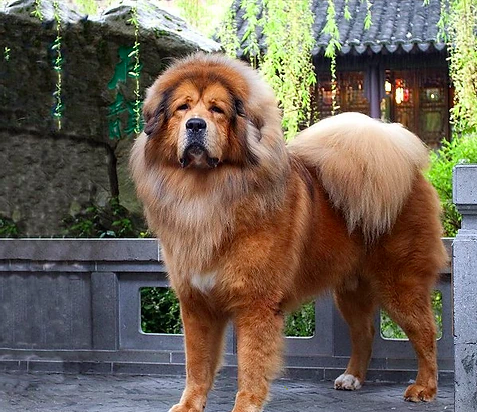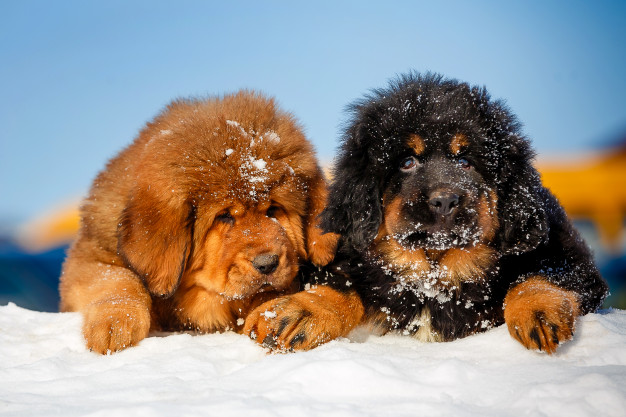The Tibetan Mastiff is a large Tibetan dog breed belonging to the mastiff family. Males can reach heights up to 83 cm (33 in). The original Tibetan Mastiff breed from its native range usually weighed 55–90 kg (121–198 lb). Its double coat is long, subject to climate, and found in a wide variety of colours, including solid black, black and tan, various shades of red (from pale gold to deep red) and bluish-grey (dilute black), often with white markings.
Names and etymology
The Tibetan Mastiff known as ‘Dogs-Khyi in Tibetan, reflects its use as a guardian of herds, flocks, tents, villages, monasteries and palaces, much as the Old English Bandog (also meaning tied dog) was a dog tied outside the home as a guardian. However, in nomad camps and villages, the ‘Dogs-Khyi is traditionally allowed to run loose at night. This dog is known for its loyalty and has been used as a nomad dog for thousands of years.
The guardian type from which the modern Tibetan Mastiff breed has been derived was known across the ancient world by many names. Bhote Kukur in Nepali as bhote means someone from Tibet and kukur means dog. The Chinese name for the breed is Zàng áo (Cantonese: Tzong ngou), meaning “Tibetan Mastiff-dog”. In Mongolia, a similar-looking dog is called bankhar, but this dog is genetically distinct (a different Traditional Native Landrace Breed) and is of a more ancient lineage.
The name Tibetan Mastiff is a misnomer; the Tibetan Mastiff is not a true Mastiff. The term “mastiff” was assigned by the Europeans who first came to Tibet because it was used to refer to nearly all large dog breeds in the West. Early Western visitors to Tibet misnamed several of its breeds: The “Tibetan Terrier” is not a terrier and the “Tibetan Spaniel” is not a spaniel. A better name for the breed might be the Tibetan Mountain Dog or, to encompass the landrace breed throughout its range, the Himalayan mountain dog.
History

The Tibetan mastiff originated as a herding and guarding dog for the nomads of Tibet, and as a watchdog in Tibetan monasteries.
The Tibetan mastiff is a phenotypically distinct dog breed that was bred as a flock guardian in the high altitudes of the Himalayas and the Tibetan Plateau.
In 1872, one writer stated:
The dogs of Thibet are twice the size of those seen in India, with large heads and hairy bodies. They are powerful animals and are said to be able to kill a tiger. During the day they are kept chained up and are let loose at night to guard their masters’ house.
In the early 20th century, King George V introduced a pair of Tibetan Mastiffs, and enough of the breed were available in England in 1906 to be shown at the Crystal Palace show. However, during the war years, the breed lost favour and focus and nearly died out in England.
After 1980, the breed began to gain in popularity worldwide. Although the breed is still considered somewhat uncommon, as more active breeders arose and produced adequate numbers of dogs, various registries and show organizations (FCI, AKC) began to recognize the breed.
Since AKC recognition, the number of active breeders has skyrocketed, leading to over-production of puppies, many of which are highly inbred and of questionable quality. Initially, the breed suffered because of the limited gene pool from the original stock, but today’s reputable breeders work hard at reducing the genetic problems through selective breeding and the international exchange of new bloodlines. However, some few breeders cling to the practice of inbreeding, do not perform health tests on their breeding stock, and do not support buyers of the puppies they produce. Many puppies and adult dogs end up in shelters and rescue situations.
In 2008, the Tibetan Mastiff competed for the first time in the Westminster Kennel Club Dog Show.
A Chinese woman was reported to have spent more than 4 million yuan to buy an 18-month-old purebred male Tibetan Mastiff, which she named the Yangtze No. 2. In March 2011, a red Tibetan Mastiff was reported to have been sold to a ‘coal baron’ from northern China for 10 million yuan. There have been other similar reports of dogs sold for astronomical prices; however, most of these appear to be breeders’ attempts to drive up the prices of their dogs. Photos of dogs shown on web sites are frequently photoshopped to exaggerate colour intensity, size, and “bone”. By 2015, due to copious production by breeders and unsuitability of the breed as a pet in urban situations, prices in China for the best dogs had fallen to about $2,000 and both lower quality and crossbreed dogs were being abandoned.
In 2013, a zoo in Louhe, China attempted to pass off a Tibetan Mastiff as an African lion.
In 2011, a DNA study concluded that there was a genetic relationship between the Tibetan Mastiff and the Great Pyrenees, Bernese Mountain Dog, Rottweiler and Saint Bernard and that these large breed dogs are probably partially descended from the Tibetan Mastiff. In 2014, a study added the Leonberger to the list of possible relatives.
Admixture with the Tibetan wolf
The Tibetan Mastiff was able to adapt to the extreme highland conditions of the Tibetan Plateau very quickly compared to other mammals such as the yak, Tibetan antelope, snow leopard, and the wild boar. The Tibetan Mastiff’s ability to avoid hypoxia in high altitudes, due to its higher haemoglobin levels compared to low-altitude dogs, was due to prehistoric interbreeding with the Tibetan wolf.
